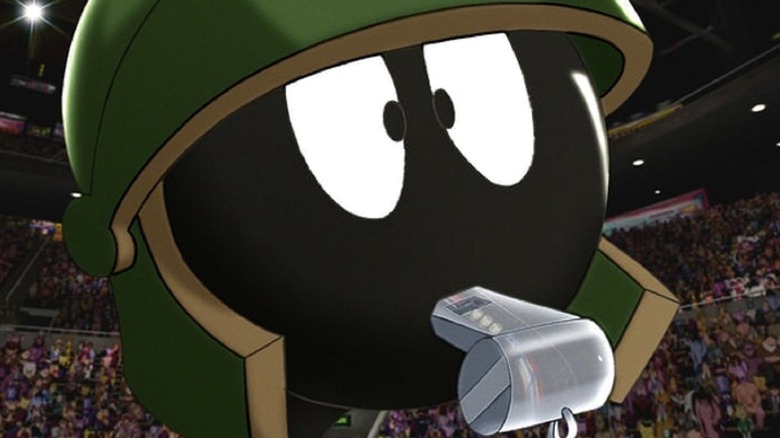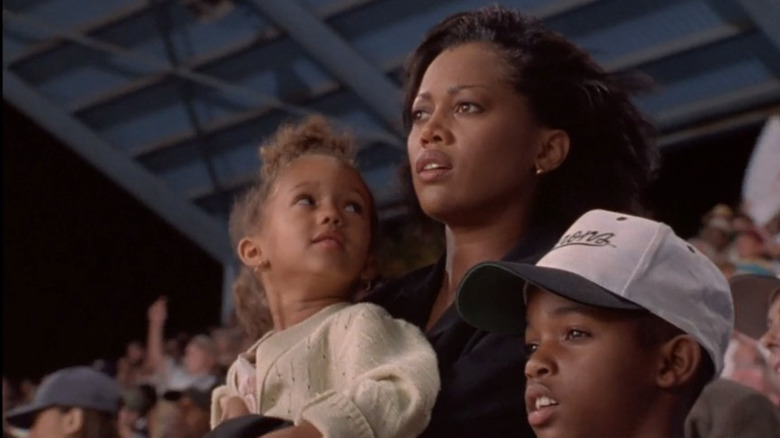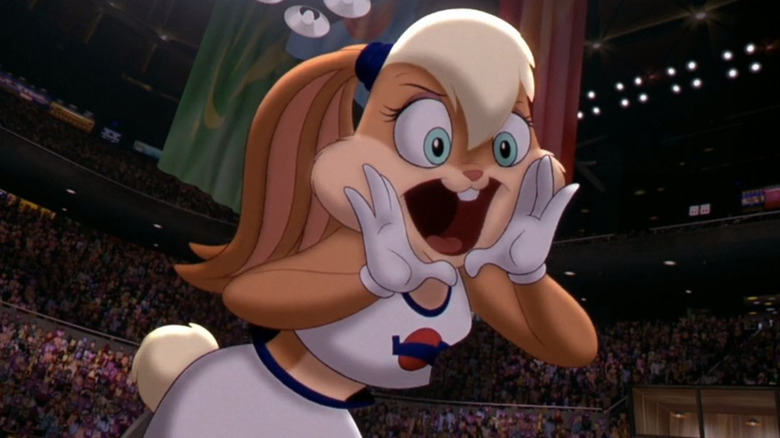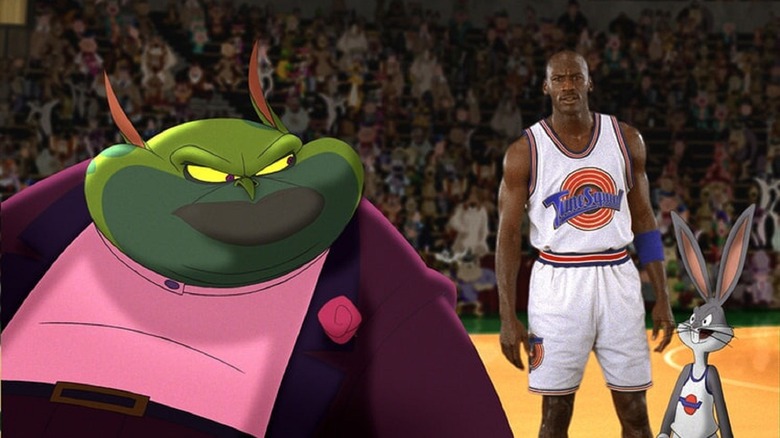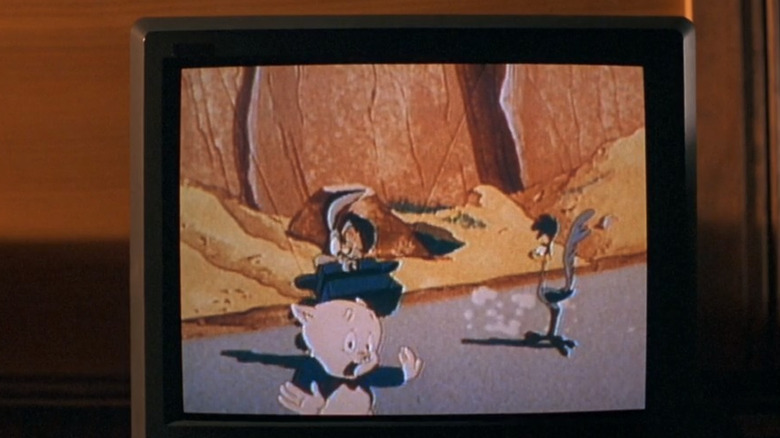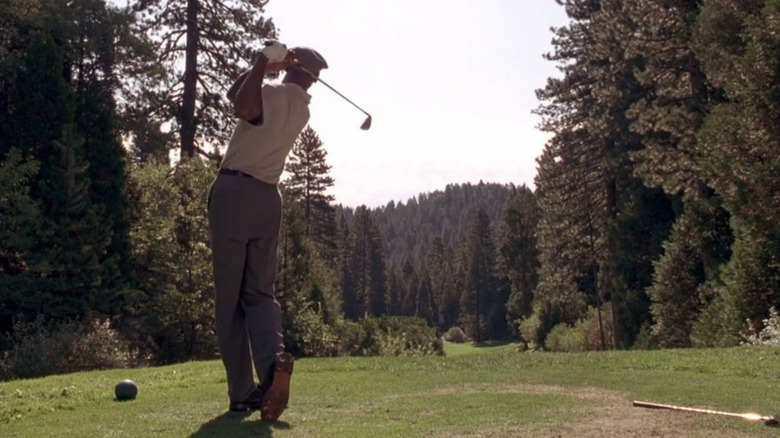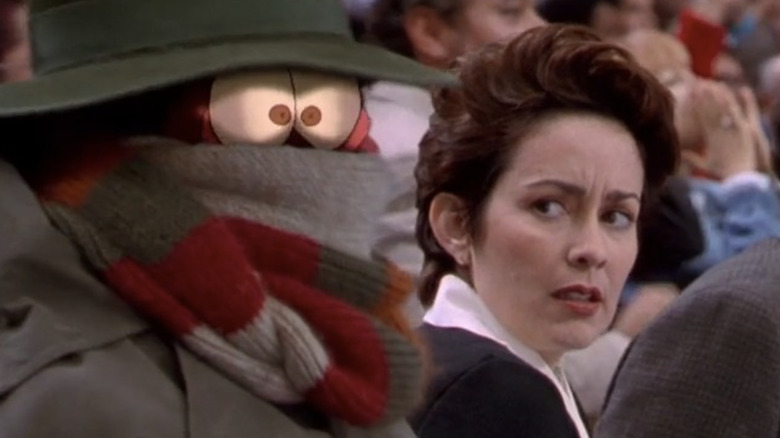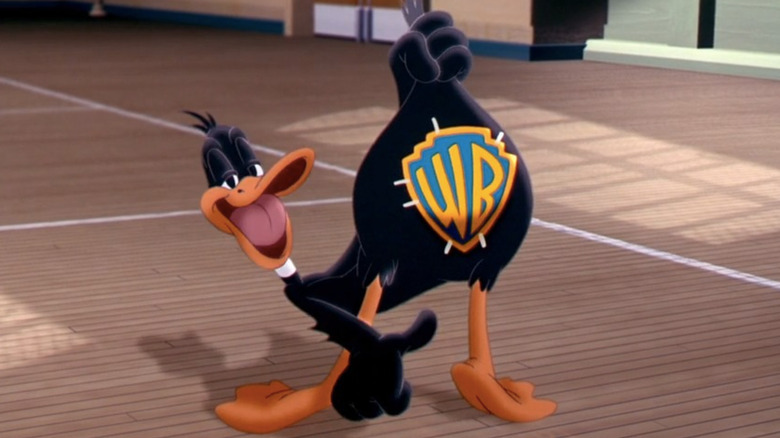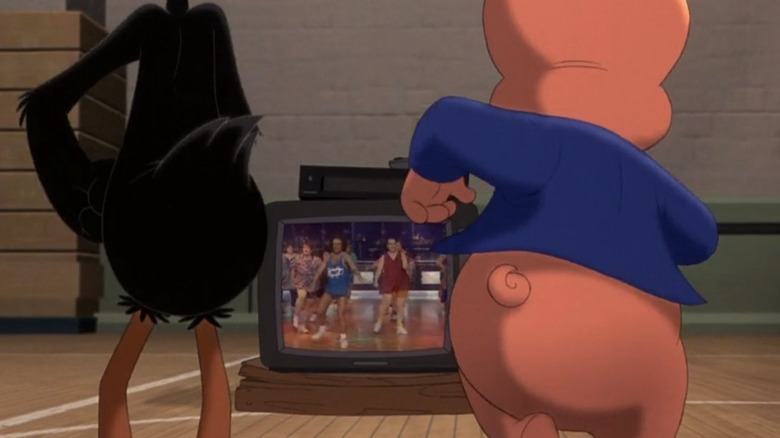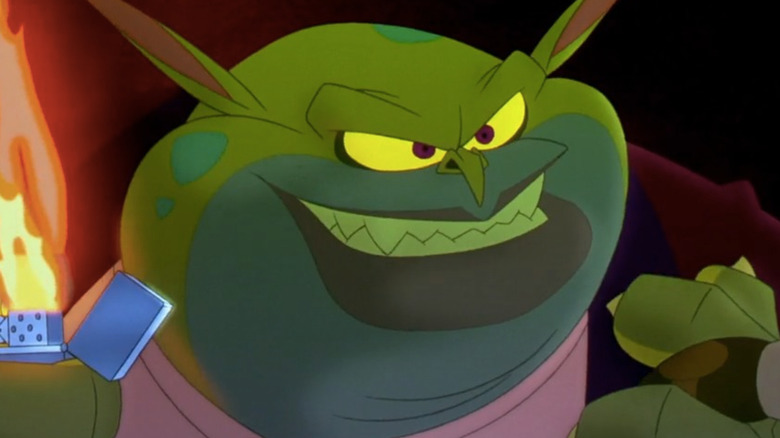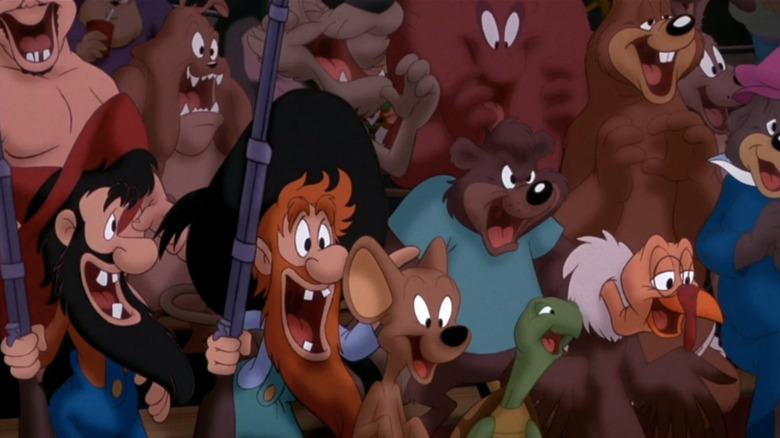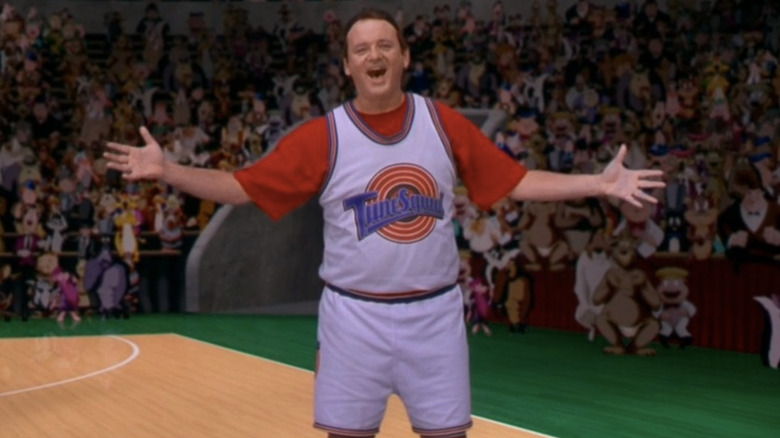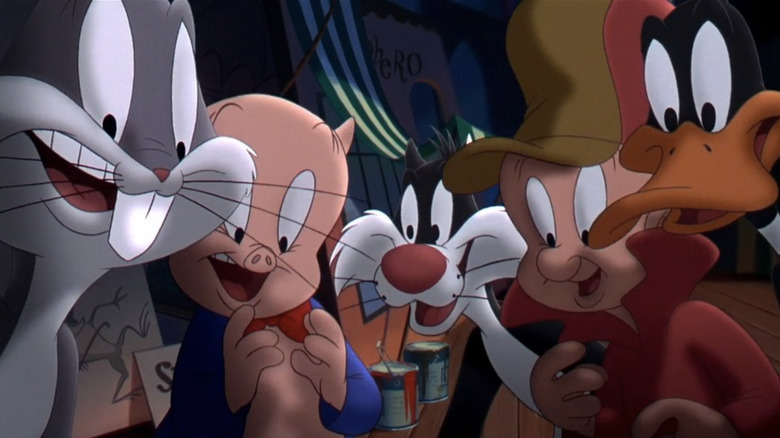Things Only Adults Notice In Space Jam
Today, Bugs Bunny and Michael Jordan are an iconic combo whose pop-culture impact together will forever be timestamped on 1996 with the release of the smash-hit film "Space Jam." But at the time, the idea of a classic "Looney Tunes" character and a star NBA player being in a movie together was an untested hypothesis. Sure, Bugs and Jordan had been in a Nike commercial together several years prior, but "Space Jam" was a different scale entirely.
The melding of seemingly disparate worlds — vintage animation and contemporary basketball — meant the film attracted a wide-reaching audience and could connect across demographics. With this in mind, "Space Jam" includes more than a few moments that likely go over kids' heads, whether intentionally with winks to adults in the audience or simply through observation beyond the surface level that comes with maturity. Some things in "Space Jam" you only notice if you're an adult. Let's take a look.
That isn't Michael Jordan's real family
Rather than embodying a fictional persona, Michael Jordan plays himself in "Space Jam." As such, his family is included among the supporting cast. They're shown together at home, and they support Michael at his games. But Jordan superfans might notice his wife and kids aren't actually portrayed by his real-life family. The structure of the family is the same, and every family member goes by the name of Michael's actual family, but the real people they depict are never shown onscreen.
Michael's then-wife, Juanita Jordan, is played by Theresa Randle, known for the "Bad Boys" film series. Michael's children, Jeffrey, Marcus, and Jasmine Jordan, are portrayed by Manner "Mooky" Washington, Eric Gordon, and Penny Bae Bridges, respectively. Bridges told Huffington Post in 2016 that people occasionally mistake her for Jordan's real daughter and still ask her for Michael's autograph, despite them not maintaining a relationship over the years.
While it would have been simply absurd to cast anyone other than Michael Jordan as Michael Jordan, perhaps Warner Bros. felt it made more sense to hire actors as Jordan's family, or maybe it was Jordan's preference for them not to appear in the movie. Similarly, 2021's "Space Jam: A New Legacy" stars LeBron James as himself, though James' wife and kids are given different names and portrayed by actors rather than his real family.
Looney Tunes needs more female characters
While an undisputedly classic ensemble of characters, the "Looney Tunes" bunch are predominantly male. Bugs Bunny, Daffy Duck, Porky Pig, Road Runner, Tasmanian Devil, Wile E. Coyote, Sylvester, Tweety Bird, Yosemite Sam, Marvin the Martian, Foghorn Leghorn, Elmer Fudd... they're all dudes. The only classic "Looney Tunes" female characters returning for "Space Jam" are a granny, an old witch, and Penelope Pussycat in a cameo. Kids might perceive this imbalance of gender equality, but might not have the words to call it what it is, while adults can clearly identify this lack of representation as problematic.
The character of Lola Bunny was created specifically for 1996's "Space Jam," perhaps to add another female character to the roster. Despite being new, Lola receives just as much screen time as the vintage characters she shares scenes with, and would go on to become part of the regular "Looney Tunes" ensemble in the franchise's projects following "Space Jam." Lola's presence doesn't solve everything, though, as her depiction in "Space Jam" is often sexualized. She's objectified for her appearance throughout the movie, and hardly a scene of hers goes by without someone commenting on her looks — though Lola is quick to always put the boys in their place, rightfully demanding they quit calling her "doll." The character's portrayal was reconsidered and revised for 2021's "Space Jam: A New Legacy."
The animation quality is pretty stellar
While most kids will simply appreciate "Space Jam" for the sum of its whole, adults may pick up on small details that push the boundaries of the film's animation. For one, the film's iconic "Looney Tunes" cast graduates from their (already impressively animated) short-film and television roots to receive feature-quality care. The fluidity of their animation is noticeably well-crafted, and extra attention is given to adding shading and shadows to their figures. Also admirable is the squeaky-clean floor of the basketball court reflecting the characters' animation as they play their game. It's a level of detail that perhaps isn't intrinsically noticed or called attention to, but that you'd feel the absence of if it wasn't there.
Elsewhere, while perhaps dated by today's standards, filmmakers implement early examples of computer animation to add a new dimension to the story. The Monstars' planet is an example of a computer-animated element that still would have felt relatively revolutionary to 1996 audiences, with computer-generated imagery still in its early years.
The cartoon characters have a union meeting
As Michael Jordan's kids watch "Looney Tunes" on TV, it becomes clear that something's not quite right. Porky Pig walks into the frame of a Wile E. Coyote segment of the program, and pleads to the powers that be, "Stop the cartoon!" He explains to Wile E. and Roadrunner, "We've got an emergency cartoon character union meeting to go to." All three characters exit the frame and leave the Jordan children looking at an empty background of a desert canyon.
Kids in the audience can pick up enough of the story from the context provided — something's wrong, and the "Looney Tunes" gang needs to gather to discuss the problem — but the specific language of a "cartoon character union meeting" probably goes over most kids' heads. The idea that such a thing exists prompts a few follow-up questions. When did this union form? What governing body does the union have tensions with? When it's not concerned with being taken hostage by aliens, what are the typical issues that the cartoon character union faces? The subsequent events render the term "union" unimportant to the story at hand, though children likely have no idea what a union is.
Michael Jordan's golf obsession
It's no secret that Michael Jordan is a versatile athlete. In "Space Jam" alone, his proficiency in basketball and baseball are center stage. In addition to playing those two sports in a professional capacity, the film shows Jordan blowing off some steam by playing golf. In the movie, golf isn't presented as a major source of conflict. Jordan's score in his golf game is unimportant outside of the bragging rights of the buddies he's playing with (including actor Bill Murray, naturally). This is in contrast to basketball and baseball, which Michael plays for a living and the scores couldn't be more important. Golf being a recreational de-stressor for Jordan in the film mirrors the athlete's obsession with golf in real life, something that younger viewers probably aren't aware of.
As shown in the hit documentary series "The Last Dance," Jordan frequently played golf to take his mind off the pressures of his high-profile basketball career. Essentially Sports points out other quirks of Jordan's golf hobby, including that he once even played with former President Bill Clinton. Unfortunately, Jordan's golf obsession often went hand in hand with a gambling problem, sometimes wagering up to $1 million. Those habits are appropriately left out of Jordan's golf proceedings in "Space Jam."
Who's who in the cast
To kids, everyone in any movie is "real." No matter how outlandish the events of a fictional story may be, younger audience members' imaginations are so vivid that they rarely question even the most fantastical of circumstances. Bugs Bunny is just as "real" as Michael Jordan because, well, why wouldn't he be?
"Space Jam" has a few different levels of its cast members that can get tricky to keep track of, even if its categorization is ultimately unimportant. There are cartoon characters, of course. There are human actors playing made-up personas, like Wayne Knight as Michael Jordan's assistant, Stan Podolak. There are well-known athletes playing themselves, who kids might recognize, like Michael Jordan or Charles Barkley. Then there are non-athletes playing themselves, like Bill Murray as a confidante of Michael. All this celebrity roulette leaves some recognizable faces unidentified in the mix, like Patricia Heaton from "Everybody Loves Raymond," who appears in the stands of a basketball game. It's not acknowledged if we are to believe this is Heaton as Heaton or Heaton as a fictional character within the universe of the movie.
These distinctions probably go right over extra-young kids' heads, though the differentiation isn't really important, anyway. It doesn't matter that Knight appears as a fictional person while Murray appears as a hyperbolized real person. They both are part of the cast and their perceived purpose to the film is clear, regardless of "who" they're playing.
The corporate synergy of Warner Bros.
Kids might recognize the Warner Bros. logo if they've seen enough of the studio's films, with the iconic, golden "WB" letters gliding into motion across a beautiful, cloud-dotted sky. But the use of corporate synergy throughout "Space Jam" and the many irreverent references to its parent company are probably more likely to be noticed by adults.
At one point, Daffy Duck even shows off a sticker taped to his backside bearing the studio logo, explaining to Michael Jordan that he and his "Looney Tunes" pals are "the exclusive property and trademark of Warner Bros., Inc." before literally kissing his own butt. This kind of blatant self-awareness wasn't a gimmick that "Space Jam" added to the characters as part of some '90s fad, but rather an extension of who they had always been. The salutes to their parent company and their awareness of belonging to a studio body had long been a staple of "Looney Tunes" cartoons and their extended properties, from "Animaniacs" to "Tiny Toons Adventures."
It's likewise a familiar vibe for those who have seen 1988's "Who Framed Roger Rabbit," which shares with "Space Jam" an affinity for pairing live-action actors with animated characters with references to those characters' storied legacies, and even includes cameos from favorite "Looney Tunes" faces.
Exercise with Richard Simmons
Even with Michael Jordan on their team, if the "Looney Tunes" gang wants any chance of beating the Monstars in basketball, they're going to need all the help they can get. In addition to regular basketball practices, the cartoon stars keep in shape by watching a Richard Simmons exercise tape.
Simmons was a prominent video workout instructor in the '80s, making the clip of his program in "Space Jam" something that probably even went over kids' heads in 1996, and certainly has little relevance to kids watching today. Given that Simmons famously led his viewers in aerobics exercises while "sweating to the oldies," with throwback songs from yesteryear as his soundtrack, it's perhaps appropriate that he's the workout instructor of choice for these classic cartoons. Simmons caused a stir several years ago for seeming to go missing, though ended up simply wanting to live a more private life away from the attention of being a public figure.
Is the villain based on Jerry Krause?
The conflict of "Space Jam" arrives in the form of Mr. Swackhammer, a green alien and business mogul, wanting the "Looney Tunes" characters, and subsequently, Michael Jordan, to come work against their will at his theme park in outer space, Moron Mountain. It turns out the antics of Bugs, Daffy, and the gang aren't just beloved on Earth. They're well-known and adored across the universe, and Swackhammer thinks the cartoon stars could be the perfect gimmick to boost business for his park.
To kids, Swackhammer is an all-around nefarious bad guy. Adults, especially close followers of the NBA, might notice something more. Particularly sparked by the 2020 Netflix docuseries "The Last Dance," which charts the story of the '90s-era Chicago Bulls basketball team, some fans wonder if Mr. Swackhammer was inspired by Jerry Krause, general manager of the Bulls at the time of the 1996 release of "Space Jam." Krause and the character bear a vague physical resemblance to one another, and, as "The Last Dance" shows, Krause and Jordan were known to butt heads. A tweet from comedian Charles Moore in April 2020 was one of the earliest viral statements to notice the similarities, and Okay Player tracks that many others soon followed. It's important to note that this likeness is purely a theory, and "Space Jam" filmmakers have never confirmed if Krause was a starting point for fleshing out Swackhammer's character.
The recycled animation
While "Space Jam" shines a spotlight on animation, it uses a few shortcuts that sharp-eyed older viewers might notice. During the big basketball game at the climax of the story, there's a lot of action happening among the "Looney Tunes" crew hanging in there, Michael Jordan doing what he does best, the Monstars dominating the court, and Bill Murray showing up to be Bill Murray. The next time you watch, though, keep an eye on the background characters who populate the crowd in the stands watching the game. The cartoon figures cycle the same few seconds of animation repeatedly, and their actions don't correlate with whatever's happening in the game.
For example, even in moments when characters take a time-out and huddle to discuss their game strategy, characters in the background still react with cheers or panic, as if the gameplay is still underway. This was likely simply a cost-effective way to inhabit the setting with figures and motion to simulate a real stadium crowd, but it's not quite seamless for those paying close attention.
This practice is hardly something exclusive to "Space Jam." Look in the background of many of your favorite childhood animated movies and television shows and you'll often see repeated animation or characters who are completely still and don't move altogether, animators hoping your attention is instead focused on the action happening in the foreground.
I didn't know Dan Aykroyd was in this picture
While several well-known actors portray fictional characters in "Space Jam," actor Bill Murray appears as himself, seemingly a good buddy of Michael Jordan who enjoys playing golf with the mega-athlete. Murray comes to Jordan's aid in the basketball game at the end of the movie. When he walks onto the court, the cartoon villain Mr. Swackhammer remarks, "I didn't know Dan Aykroyd was in this picture."
Aside from breaking the fourth wall and acknowledging that he's in a movie, Swackhammer's line probably doesn't land as a joke for kids the way that it might elicit a small chuckle out of adults. By 1996, Bill Murray and Dan Aykroyd's careers had many times crossed paths, having collaborated on early seasons of "Saturday Night Live" and the blockbuster film "Ghostbusters," among other projects. It would have been natural to associate the two actors together and perhaps, in Swackhammer's case, mistake one for the other.
The animation directors have gone on to have prolific careers
Animation aficionados staying for the end credits of "Space Jam" might recognize a few familiar names among the crew, most notably animation directors Bruce W. Smith and Tony Cervone. "Space Jam" was one of the highest-profile projects thus far for both filmmakers' careers, and they each went on to achieve continued success within the animation industry.
Following "Space Jam" in 1996, Smith was a supervising animator at Walt Disney Animation Studios, where he brought to life characters like Kerchak in 1999's "Tarzan," Pacha in 2000's "The Emperor's New Groove," and Doctor Facilier in 2009's "The Princess and the Frog." He also created "The Proud Family" for Disney Television Animation in 2001 and recently served as executive producer for 2022's "The Proud Family: Louder and Prouder."
Cervone utilized "Space Jam" as a foundation for further work with Warner Bros. Over the years, he has produced, written, and directed a number of projects featuring some of the studio's most beloved franchises, including "Tom and Jerry," "Scooby-Doo," "The Flintstones," and, of course, "Looney Tunes." Cervone recently directed the 2020 feature-length film "Scoob!"
